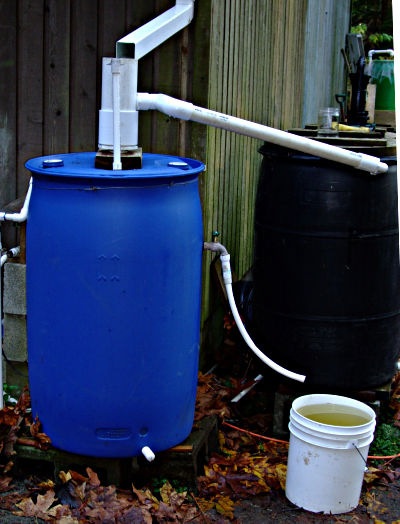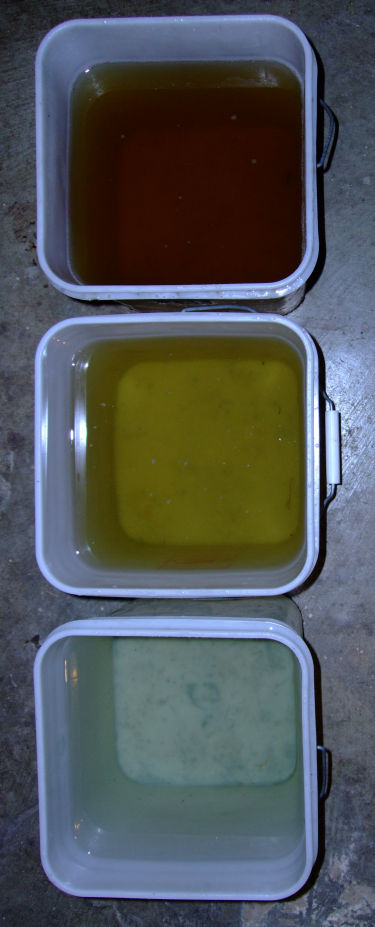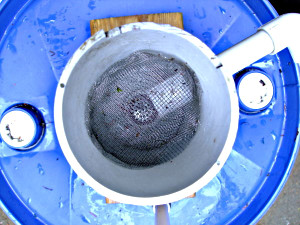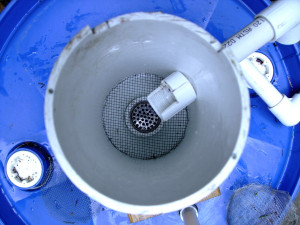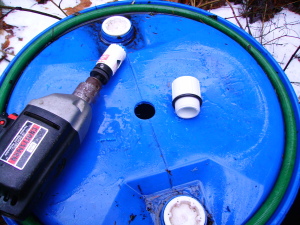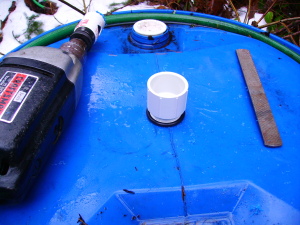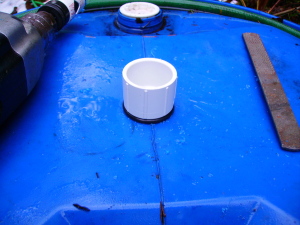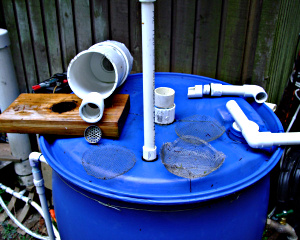|
|
|
|||
|
First flush
diverter:
After a dry spell, this device diverts the first most polluted flow of rainwater from the roof away from the water harvesting system. The recommended minimum rate of diversion is 1 gallon per 100 square feet of roof surface. This diverter uses 2 gallons per 100 square feet.
NEW: 2012-07-27 Two more diverters similar to the one shown here with the float seal device have now been built. (See roofwaterharvesting.org, for more details. The most recent diverter has not been documented on the website yet.) They both work flawlessly, here. The rainfall here is very seldom heavy. Most rainfall here occurs as light to moderate continuous rain over several days or weeks. In areas where very heavy rainfall occurs, larger pipes will be needed. This diverter will handle 20 litres per minute of flow, this is the equivalent of a heavy rainfall event here in western Washington state. Obviously, much heavier rainfall does occur elsewhere.
2011-05-02 Part one of the first flush diverter construction is up on YouTube. https://www.youtube.com/watch?v=ch-YsD9rOGk This is part one covering the input device and the float seal.
2011-10-30 part 2 is up on YouTube. https://youtu.be/QS14RgLXWyA
2009-08-10: The first major rainfall in 10 weeks just occurred: .7 inches of rain in 12 hours. After the 55 gallon space in the diverter storage space was filled, the operation was monitored for several hours at one downspout draining a 1000 square foot surface area. It was necessary to quickly drain 20 gallons to allow more washing to occur. The 55 gallon space was NOT sufficient to satisfactorily provide clean water, although the most polluted runoff was kept out of the system. Without the diverter, the runoff would be of limited use and would quickly impede the flow of water through the slow sand filter. The roof surface has been dry for 10 weeks, and additionally, from 2009-07-26 to 2009-07-31 temperatures here (in the shade) were well into the upper 90's and above 100 deg F for 3 consecutive days (all time record high temps for this area) and the roof is a composition roof. The diverter had been totally emptied and cleaned on 2009-08-09 (yesterday) and the gutters and roof surface had been cleared of leaves, small loose roofing particles, small twigs, and other organic substances that had accumulated during the dry spell. At least 75 to 100 gallons of diversion should be available in this situation (extended dry periods during the summer). It should be noted that this location is heavily wooded and there are numerous large 100 year old fir trees and maple trees surrounding the roof area, and additionally the roof has moss covering 30 percent of the area being monitored.
Note change to output pipe size as of Nov. 15 2009
After a dry spell, this device diverts the first most polluted flow of rainwater from the roof away from the water harvesting system. The recommended minimum rate of diversion is 1 gallon per 100 square feet of roof surface. This diverter uses 2 gallons per 100 square feet.
NEW: 2012-07-27 Two more diverters similar to the one shown here with the float seal device have now been built. (See roofwaterharvesting.org, for more details. The most recent diverter has not been documented on the website yet.) They both work flawlessly, here. The rainfall here is very seldom heavy. Most rainfall here occurs as light to moderate continuous rain over several days or weeks. In areas where very heavy rainfall occurs, larger pipes will be needed. This diverter will handle 20 litres per minute of flow, this is the equivalent of a heavy rainfall event here in western Washington state. Obviously, much heavier rainfall does occur elsewhere.
2011-05-02 Part one of the first flush diverter construction is up on YouTube. https://www.youtube.com/watch?v=ch-YsD9rOGk This is part one covering the input device and the float seal.
2011-10-30 part 2 is up on YouTube. https://youtu.be/QS14RgLXWyA
2009-08-10: The first major rainfall in 10 weeks just occurred: .7 inches of rain in 12 hours. After the 55 gallon space in the diverter storage space was filled, the operation was monitored for several hours at one downspout draining a 1000 square foot surface area. It was necessary to quickly drain 20 gallons to allow more washing to occur. The 55 gallon space was NOT sufficient to satisfactorily provide clean water, although the most polluted runoff was kept out of the system. Without the diverter, the runoff would be of limited use and would quickly impede the flow of water through the slow sand filter. The roof surface has been dry for 10 weeks, and additionally, from 2009-07-26 to 2009-07-31 temperatures here (in the shade) were well into the upper 90's and above 100 deg F for 3 consecutive days (all time record high temps for this area) and the roof is a composition roof. The diverter had been totally emptied and cleaned on 2009-08-09 (yesterday) and the gutters and roof surface had been cleared of leaves, small loose roofing particles, small twigs, and other organic substances that had accumulated during the dry spell. At least 75 to 100 gallons of diversion should be available in this situation (extended dry periods during the summer). It should be noted that this location is heavily wooded and there are numerous large 100 year old fir trees and maple trees surrounding the roof area, and additionally the roof has moss covering 30 percent of the area being monitored.
Note change to output pipe size as of Nov. 15 2009
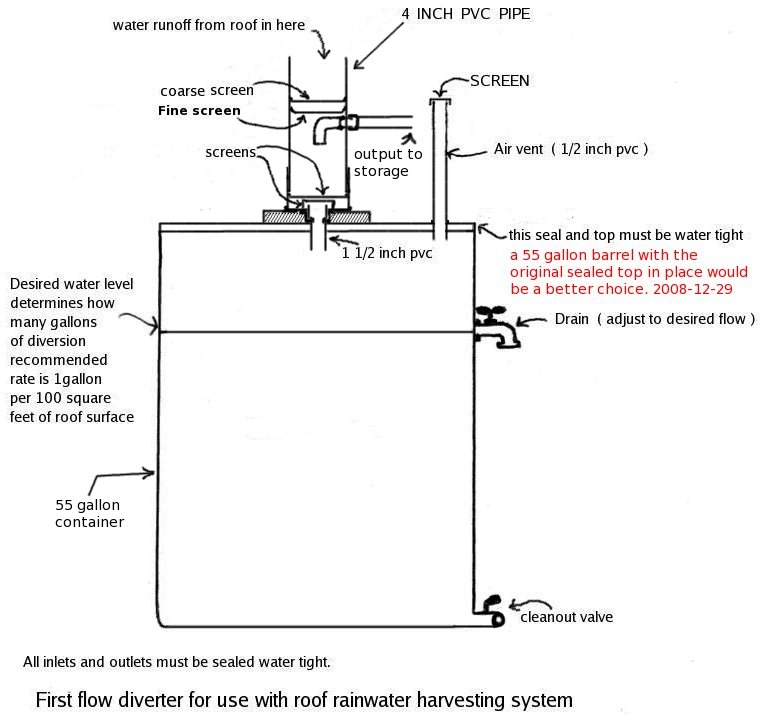 First flush diverter drawing Note: the output to storage pipe is designed for light to moderate rainfall events. In areas where very heavy rainfall occurs, the pipe should be at least 1 1/2 inch diameter; see first flush diverter photo below. (1 1/2 inch pipe allows 24 liters per minute flow). 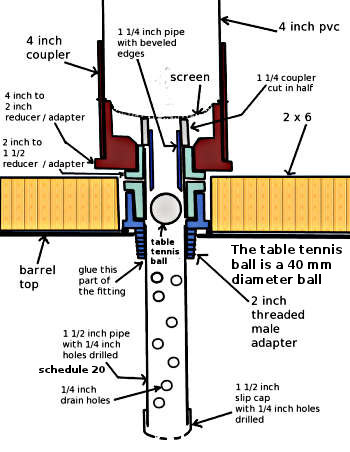 Drawing of float seal device First flush diverter with float seal (external link) 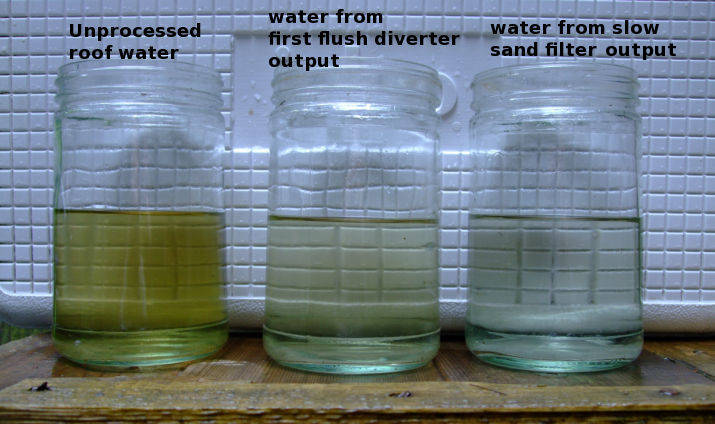 2009-08-10 Water samples from the roofwater harvesting system. Each container is 16.5 cm high by 9 cm in diameter and contains 1/2 litre of water. (1 inch = 2.54 cm), (1 gallon = 3.785 litres) |
|||||||
what about here |
|||||||
Page design by Perpetual PC's

This work is licensed under a Creative Commons Attribution-Noncommercial-Share Alike 3.0. terms of use

